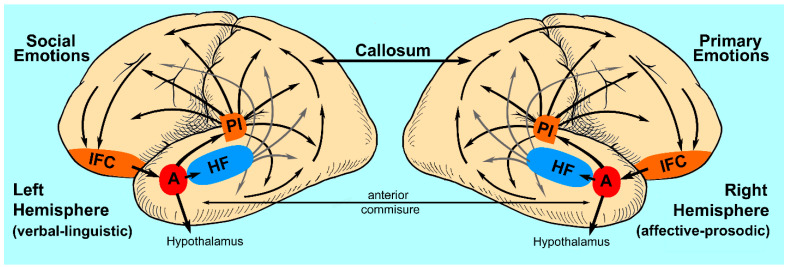Figure 4.
A schematized drawing depicting the emotional and mnestic pathways and neural networks that are involved with emotions, memory, executive functions and cognitive appraisal that ultimately furnish feedback to the amygdala and hippocampal formation (A = amygdala; HF = hippocampal formation; IFC = infero-frontal cortex; PI = posterior insula). Not shown are the ipsilateral parallel convergent inputs from the primary visual, somatosensory and auditory cortices that convey exteroceptive information to the amygdala and hippocampal [15]. The nodal point for processing exteroceptive information into memory is the hippocampal formation. However, the mnestic information is actually stored in the modality specific (unimodal) and higher-order (heteromodal) associational regions of the neocortex as a parallel distributed neural network (multiple gray arrows) [4,14,15,31,184]. This storage region is functionally equivalent to Wernicke’s ideational areas for propositional language and the right hemisphere’s equivalent for affective prosody (see Figure 1). The nodal point for generating an emotional reaction to exteroceptive information is the amygdala and its dense connections with the posterior insula. However, experiencing an emotion and storing it into memory is accomplished through a parallel distributed neural network (multiple black arrows) with the posterior insula serving as a nodal point in conjunction with and the unimodal and heteromodal associational regions of the neocortex [4,5,14,31,184]. The amygdala also has the capability of enhancing or diminishing the strength of factual memories stored in neocortex via its efferent connections to the hippocampal formation (short black arrows). The factual and emotional memories stored mainly in the posterior neocortices can, in turn, be relayed to the prefrontal neocortices for complex cognitive processing involving executive control of behavior (lateral pre-frontal areas) and cognitive appraisal of emotions (inferior and medial pre-frontal regions) that, in turn, can furnish feedback to the amygdala and hippocampal formation via efferent connections from the inferior frontal cortex. The emotional and mnestic information that is processed by each hemisphere can be shared via distributed connections that travel through the corpus callosum and anterior commissure. The temporal limbic system of each hemisphere has, at best, meager inter-hemispheric connections with each other. Figure reproduced from Ross, E.D. Differential hemispheric lateralization of emotions and related display behaviors: Emotion-type hypothesis. Brain Sci. 2021, 11, 1034, 2021 (Figure 1) [4] with permission.

